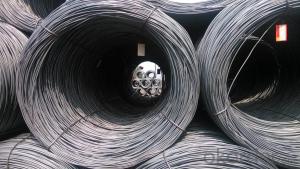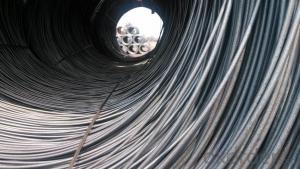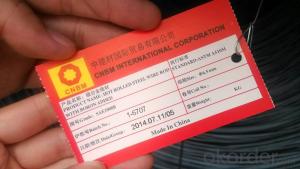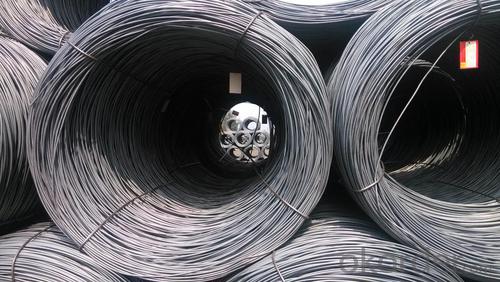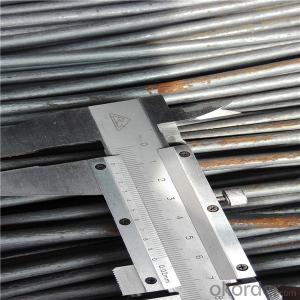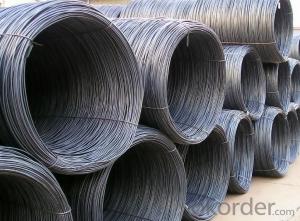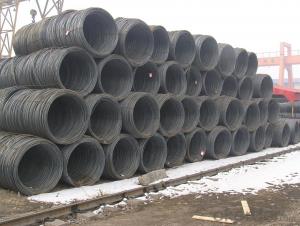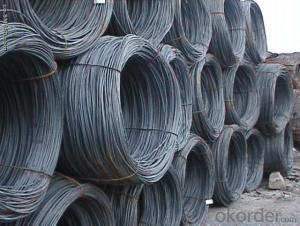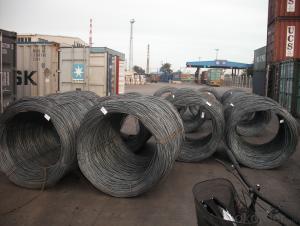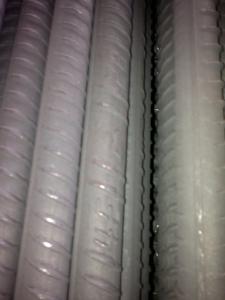Steel Wire Rods Hot Rolled Low Carbon Prime Quality Best Selling
- Loading Port:
- Qingdao
- Payment Terms:
- TT OR LC
- Min Order Qty:
- 500 m.t.
- Supply Capability:
- 50000 m.t./month
OKorder Service Pledge
OKorder Financial Service
You Might Also Like
1.Structure of Wire Rod Steel for Construction Description
Wire rod steel is widely used for commercial building structure, pre-engineering buildings, machinery support structures, prefabricated structure, medium scale bridges and so on. We have supplied this product for many years and gained widespread reputation.
2.Main Features of the Wire Rod Steel for Construction
fasteners, bolts, rivets, screws,
general purpose wires,
electrode wires, industrial wires, agriculture wires,
bush wires, chain rivet wires,
detonator wire,
Umbrella ribs, upholstery wires, cycle spokes, needle wires, heald wires, staple pin Wire, safety pin wires
ACSR wires, earth wires,
tyre and hose reinforcement wires,
prestressed concrete wire, springs and rope wires,
card clothing wires,
vineyard wires,
ball bearing quality
Automobile parts like screw, fasteners, bush, spline, socket, connecting rod, shaft, gear, rivets, engine shaft, connecting rod, spindles, gears, etc.
3.Wire Rod Steel for Construction Images

4.Wire Rod Steel for Construction Specification

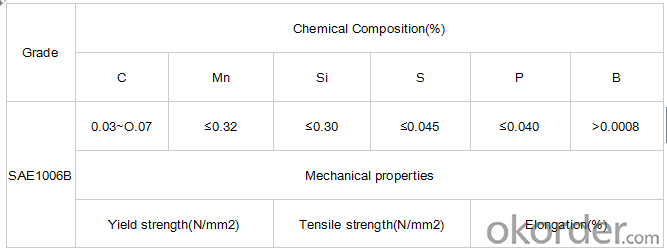
5.FAQ of Wire Rod Steel for Construction
We have organized several common questions for our clients,may help you sincerely:
1.What is your minimum order quantity ?
Our MOQ is 500mt for each size. And we will consider to give more discount if you make big order like 10000 tons and more. Further more, the more appropriate payment term your offer the better price we can provide.
2.Please tell me the daily output and wire rod mill’s brand ?
Our daily output is 4000mt/day and our rolling mill from Germany’s SMS MEER
3.Which countries are your main sales?
Thanks to the professional international trade team, solid distribution channel and long – term cooperation customers, our market share in overseas realizes a tremendous growth, now we already became a main player in Middle East and South East Asia. Meanwhile, we are also the biggest supplier of Pre-painted galvanized steel coil in Philippines, Saudi Arabia, United Arab Emirates, Iran, Sudan etc.
- Q: How is steel wire rod used in the manufacturing of wire for shopping baskets?
- Steel wire rod is an essential component in the manufacturing of wire for shopping baskets. It serves as the raw material that is transformed into wire through a series of manufacturing processes. The steel wire rod is first heated and then passed through a series of rollers to gradually reduce its thickness and increase its length. This process is known as drawing and it helps to improve the tensile strength and flexibility of the wire. Once the wire is drawn, it is typically coated with a protective layer to prevent corrosion and enhance its durability. This coating can be made of materials such as zinc or plastic. The coated wire is then shaped into the desired form, which in the case of shopping baskets, is usually a mesh-like structure. This shaping is done through a process called welding, where the wire is bent and joined at specific points to form the basket shape. The steel wire rod used in the manufacturing of wire for shopping baskets is chosen for its strength, resilience, and ability to withstand heavy loads. It ensures that the shopping baskets are sturdy enough to carry various items without bending or breaking. Additionally, the steel wire rod's corrosion resistance properties ensure that the wire and ultimately the shopping baskets have a longer lifespan, even when exposed to moisture or harsh environments. In summary, steel wire rod plays a crucial role in the manufacturing of wire for shopping baskets. It provides the raw material needed to produce the wire, which is then coated, shaped, and welded to create the final product. The strength, resilience, and corrosion resistance of the steel wire rod ensure that the shopping baskets are durable, long-lasting, and capable of withstanding the demands of everyday use.
- Q: What are the different cleanliness testing methods for steel wire rod?
- There are several cleanliness testing methods for steel wire rod, including visual inspection, magnetic particle inspection, ultrasonic testing, and chemical analysis. Visual inspection involves a thorough visual examination of the wire rod to check for any visible dirt, scale, rust, or other contaminants. Magnetic particle inspection uses magnetic fields and iron particles to detect surface and near-surface defects or contaminants. Ultrasonic testing utilizes high-frequency sound waves to detect internal defects or inclusions in the wire rod. Chemical analysis involves taking samples from the wire rod and analyzing them to determine the presence and concentration of various elements or compounds that could affect cleanliness. These testing methods are important to ensure the quality and cleanliness of steel wire rods for various applications.
- Q: What are the different fatigue testing methods for steel wire rod?
- There are several fatigue testing methods for steel wire rods, including rotating bending fatigue tests, axial fatigue tests, torsional fatigue tests, and fretting fatigue tests. Each method has its own advantages and is used to evaluate the fatigue performance of steel wire rods under different loading conditions.
- Q: How is steel wire rod used in the manufacturing of wire for construction reinforcement grids?
- Steel wire rod is used in the manufacturing of wire for construction reinforcement grids as it serves as the primary raw material. This wire rod is drawn through a series of dies to reduce its diameter and increase its length, resulting in a thinner wire that is strong and durable. This wire is then further processed and woven into a grid pattern to create wire mesh sheets, which are commonly utilized in construction projects to reinforce concrete structures, such as floors, walls, and foundations. The high tensile strength and flexibility of steel wire rod make it an ideal choice for construction reinforcement grids, ensuring structural integrity and providing enhanced resistance against cracks and fractures.
- Q: What are the future prospects for the steel wire rod industry?
- The future prospects for the steel wire rod industry are positive due to increasing demand from various sectors such as construction, automotive, and manufacturing. With the growing infrastructure development and urbanization in emerging economies, the demand for steel wire rods is expected to rise. Additionally, the shift towards electric vehicles and renewable energy infrastructure will drive the need for steel wire rods in their production. However, the industry may face challenges such as fluctuating raw material prices and competition from alternative materials. Overall, the steel wire rod industry is poised for growth in the coming years.
- Q: How is steel wire rod used in the production of wire mesh reinforcement?
- Steel wire rod is an essential component in the production of wire mesh reinforcement. It serves as the main raw material for manufacturing wire mesh, which is widely used in construction and other industries for reinforcing concrete structures. To produce wire mesh reinforcement, steel wire rod is first processed through a series of manufacturing steps. The rod is typically drawn through a series of dies to reduce its diameter and increase its length. This process, known as wire drawing, results in a thinner and longer wire with improved mechanical properties. The drawn wire is then fed into a specialized machine called a wire mesh welding machine. This machine uses electric resistance welding to join the wires together, forming a grid-like pattern. The welding process ensures that the wires are securely bonded at their intersections, creating a sturdy and durable wire mesh. The wire mesh reinforcement is used in various construction applications, such as in the construction of concrete slabs, walls, and columns. It is embedded in concrete structures to provide additional strength, prevent cracking, and increase the overall load-bearing capacity. The wire mesh acts as a reinforcement, distributing the forces and stresses evenly across the concrete, thereby enhancing its structural integrity. Furthermore, wire mesh reinforcement is also utilized in other industries, including agriculture, mining, and manufacturing. In agriculture, it is commonly used as fencing to secure livestock and crops. In mining, wire mesh is employed for safety purposes, such as preventing rockfalls and supporting tunnel walls. In manufacturing, wire mesh is utilized for filtration, separation, and containment purposes, among others. In summary, steel wire rod plays a crucial role in the production of wire mesh reinforcement. Its transformation through wire drawing and subsequent welding forms the basis for creating durable and versatile wire mesh. This reinforcement is widely used in construction and other industries to enhance the strength and integrity of various structures.
- Q: What are the different types of steel wire rod finishes for improved paint adhesion?
- There are several types of steel wire rod finishes that can enhance paint adhesion. Some common finishes include phosphatized, galvanized, and chromated finishes. Phosphatized finishes involve the application of a phosphate coating, which creates a surface that promotes better paint adhesion. Galvanized finishes involve the application of a protective zinc coating, which not only enhances paint adhesion but also provides corrosion resistance. Chromated finishes, on the other hand, involve the application of a chromium-based coating, which improves both adhesion and corrosion resistance. These different finishes offer various levels of paint adhesion improvement and are chosen based on the specific requirements of the application.
- Q: What are the different types of steel wire rod packaging options?
- There are several types of steel wire rod packaging options available, including coils, bundles, and spools. Coils are the most common packaging option, where the wire rod is wound in a circular shape. Bundles involve grouping multiple wire rods together and securing them with straps or wires. Spools, on the other hand, are used for smaller quantities and involve winding the wire rod onto a cylindrical or conical spool.
- Q: What are the potential applications of stainless steel wire rod?
- The unique properties and versatility of stainless steel wire rod make it suitable for a wide range of applications. Some of these applications include: 1. Construction and infrastructure: Stainless steel wire rod is often used in construction and infrastructure projects due to its strength, durability, and resistance to corrosion. It can be utilized in the production of reinforcement bars, concrete structures, bridges, and other crucial infrastructure components. 2. Automotive industry: Stainless steel wire rod is employed in the manufacturing of different automotive components, such as exhaust systems, suspension springs, and engine parts. Its excellent resistance to heat, corrosion, and high temperatures makes it ideal for demanding automotive applications. 3. Aerospace industry: The lightweight nature and high strength-to-weight ratio of stainless steel wire rod make it suitable for the aerospace industry. It is used in the production of aircraft components, including fasteners, cables, and structural elements, where corrosion resistance and mechanical properties are vital. 4. Medical equipment: Stainless steel wire rod is widely used in the production of medical equipment and instruments due to its biocompatibility, corrosion resistance, and ease of sterilization. Surgical tools, implants, orthodontic wires, and other medical devices are made using stainless steel wire rod. 5. Power generation: The power generation industry utilizes stainless steel wire rod for its excellent resistance to high temperatures, pressure, and corrosion. It is commonly used in the production of turbine blades, heat exchangers, and other critical components in power plants. 6. Food processing industry: Stainless steel wire rod is extensively used in the food processing industry because of its hygienic properties and resistance to corrosion. It is employed in the production of food handling equipment, storage tanks, and processing machinery. 7. Wire products: Various wire products, such as springs, wire mesh, cables, and fencing, are made using stainless steel wire rod. Its high tensile strength, corrosion resistance, and flexibility make it suitable for these applications. 8. Marine industry: The marine industry relies on stainless steel wire rod for its resistance to corrosion in saltwater environments. It is used in the production of marine equipment, boat fittings, rigging, and other components. In conclusion, stainless steel wire rod has vast and diverse potential applications, spanning across industries such as construction, automotive, aerospace, medical, power generation, food processing, wire products, and the marine sector. Its exceptional properties make it a reliable and preferred material for critical applications that require strength, durability, and corrosion resistance.
- Q: What are the different grain size measurement methods for steel wire rod?
- Steel wire rod is commonly measured using various grain size measurement methods. These methods provide crucial information about the microstructure and mechanical properties of the steel. One method widely utilized is the ASTM E112 standard, which employs a microscope to measure the average grain size. To apply this method, a metallographic sample is prepared and polished to a mirror-like finish. Subsequently, the sample is etched to reveal the grain boundaries. Under a microscope, the grain boundaries are then traced and counted to determine the average grain size. Another technique is the Sieve Analysis method, frequently employed to determine the grain size distribution in steel wire rod. This method entails sieving a representative sample of the wire rod through a series of progressively smaller mesh sieves. The weight of material retained on each sieve is measured, and the grain size distribution is determined based on the percentage of retained material. The Laser Diffraction method is another frequently used approach for measuring grain size in steel wire rod. In this method, a suspension of wire rod particles is subjected to a laser beam, and the resulting scattering pattern is measured. Particle size can be determined based on the diffraction pattern, allowing for the calculation of the grain size distribution. Additional methods include the Electron Backscatter Diffraction (EBSD) method, which utilizes an electron microscope to determine crystallographic orientation and grain boundaries in the wire rod, and the X-ray Diffraction (XRD) method, which measures the angle of X-ray diffraction to determine crystallographic structure and grain size. Each of these grain size measurement methods possesses distinct advantages and limitations. The choice of method depends on factors such as the desired level of accuracy, the type of steel wire rod being analyzed, and the available equipment and expertise.
Send your message to us
Steel Wire Rods Hot Rolled Low Carbon Prime Quality Best Selling
- Loading Port:
- Qingdao
- Payment Terms:
- TT OR LC
- Min Order Qty:
- 500 m.t.
- Supply Capability:
- 50000 m.t./month
OKorder Service Pledge
OKorder Financial Service
Similar products
Hot products
Hot Searches
Related keywords
